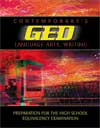 |  Contemporary's GED Language Arts, Writing Ellen Carley Frechette
Tim Collins
New for 2002!Contemporary's GED Language Arts, Writing is correlated to the 2002 GED Language Arts, Reading Test: | New Test Feature: | Book Reference: |
|---|
| PART I: EDITING | Types of documents (200–300 word passages, 12–18 numbered sentences)
- Business documents (letters, memos, meeting notes, company brochures)
- "How-to" or instructional texts (securing a job, writing a resume, dressing for success, leasing a car, how to get to a specific location)
- Informational mailings (explanation of how something functions, position papers, critical evaluations, support papers)
| All three types of documents are used in practice exercises and on the pretest, posttest, and practice test | | Full-page format for documents | Documents appear in full-page format on the pretest, posttest, and practice test | Organization: new content area (15% of the questions)
- Add, remove, or reposition a sentence
- Add a topic sentence
- Combine paragraphs
- Begin a new paragraph
| Chapter 4: Organization covers all areas that will be tested | | No spelling (except for homonyms) | Spelling Homonyms section is included in Chapter 6, Mechanics | | PART II: THE ESSAY | | 4-point scoring guide with a passing score of 2 or higher | GED Essay Scoring Guide is explained in Chapters 8 and 12; Raising Your Score activities explain how to use the scoring guide as a revision tool |
|
|



 2002 McGraw-Hill Higher Education
2002 McGraw-Hill Higher Education

 2002 McGraw-Hill Higher Education
2002 McGraw-Hill Higher Education